- Home
- Robin Cook
Blindsight Page 2
Blindsight Read online
Page 2
“Sara Wetherbee?” a voice asked, rousing Sara from her reverie.
“Yes?” Sara said as she looked up.
A young doctor sporting a heavy five o’clock shadow and a white coat slightly splattered with blood had materialized in front of her.
“I’m Dr. Murray,” he said. “Would you mind coming with me. I’d like to talk with you for a moment.”
“Of course,” Sara said nervously. She got to her feet and pulled her purse high on her shoulder. She hurried after Dr. Murray, who’d turned on his heels almost before she’d had a chance to respond. The same white doors that had swallowed Duncan three hours before closed behind her. Dr. Murray had stopped just inside and turned to face her. She anxiously looked into the man’s eyes. He was exhausted. She wanted to see some glimmer of hope, but there wasn’t any.
“I understand you are Mr. Andrews’ girlfriend,” Dr. Murray said. Even his voice sounded tired.
Sara nodded.
“Normally we talk to the family first,” Dr. Murray said. “But I know you came in with the patient and have been waiting. I’m sorry it has taken so long to get back to you, but several gunshot victims came in right after Mr. Andrews.”
“I understand,” Sara said. “How is Duncan?” She had to ask, even though she wasn’t sure she wanted to know.
“Not so good,” Dr. Murray said. “You can be sure our EMTs tried everything. But I’m afraid Duncan passed away anyway. Unfortunately, he was DOA. Dead on arrival. I’m sorry.”
Sara stared into Dr. Murray’s eyes. She wanted to see a glint of the same sorrow that was welling up inside of her. But all she saw was fatigue. His apparent lack of feeling helped her maintain her own composure.
“What happened?” she asked almost in a whisper.
“We’re ninety percent sure that the immediate cause was a massive myocardial infarction, or heart attack,” Dr. Murray said, obviously more comfortable with his medical jargon. “But the proximate cause appears to be drug toxicity or overdose. We don’t know yet what his blood level was. That takes a bit more time.”
“Drugs?” Sara said with disbelief. “What kind of drug?”
“Cocaine,” said Dr. Murray. “The EMTs even brought in the needle he’d used.”
“I never knew Duncan used cocaine,” Sara said. “He said he didn’t use drugs.”
“People always lie about sex and drugs,” Dr. Murray said. “And with cocaine sometimes it only takes once. People don’t realize how deadly the stuff can be. Its popularity has lulled people into a false sense of security. Be that as it may, we do have to get in touch with the family. Would you know the telephone number?”
Stunned by Duncan’s death and the revelation about his apparent cocaine use, Sara recited the Andrews’ phone number in a dazed monotone. Thinking about drugs allowed her to avoid thinking about death. She wondered how long Duncan had been on cocaine. It was all so hard to understand. She’d thought she’d known him so well.
1
* * *
November
6:45 a.m., Monday
New York City
The alarm of the old Westclox windup never failed to yank Laurie Montgomery from the depths of blessed sleep. Even though she’d had the clock since the first year of college, she’d never become accustomed to its fearful clatter. It always woke her up with a start, and she’d invariably lunge for the cursed contraption as if her life depended on her getting the alarm shut off as soon as humanly possible.
This rainy November morning proved no exception. As she replaced the clock on the windowsill, she could feel her heart thumping. It was the squirt of adrenaline that made the daily episode so effective. Even if she could have gone back to bed, she’d never have gotten back to sleep. And it was the same for Tom, her one-and-a-half-year-old half-wild tawny tabby who, at the sound of the alarm, had fled into the depths of her closet.
Resigned to the start of another day, Laurie stood up, wiggled her toes into her sheepskin slippers, and turned on the TV to the local morning news.
Her apartment was a small, one-bedroom affair on Nineteenth Street between First and Second avenues in a six-story tenement. Her rooms were on the fifth floor in the rear. Her two windows faced out onto a warren of overgrown backyards.
In her tiny kitchen she turned on her coffee machine. The night before, she’d prepared it with a packet of coffee and the right amount of water. With the coffee started she padded into the bathroom and looked at herself in the mirror.
“Ugh!” she said as she turned her face from side to side, viewing the damage of another night with not enough sleep. Her eyes were puffy and red. Laurie was not a morning person. She was a confirmed night owl and frequently read until all hours. She loved to read, whether the book was a ponderous pathology text or a popular bestseller. When it came to fiction, her interests were catholic. Her shelves were crammed with everything from thrillers to romantic sagas, to history, general science, and even psychology. The night before it had been a murder mystery, and she’d read until she’d finished the book. When she’d turned out the light, she’d not had the courage to look at the time. As usual, in the morning she vowed never to stay up so late again.
In the shower Laurie’s mind began to clear enough to start going over the problems that she would have to address that day. She was currently in her fifth month as an associate medical examiner at the Office of the Chief Medical Examiner for the City of New York. The preceding weekend, Laurie had been on call, which meant that she worked both Saturday and Sunday. She’d performed six autopsies: three one day and three the next. A number of these cases required additional follow-up before they could be signed out, and she began making a mental list of what she had to do.
Stepping out of the shower, Laurie dried herself briskly. One thing she was thankful about was that today would be a “paper day” for her, meaning that she would not be assigned any additional autopsies. Instead she would have the time to do the necessary paperwork on the autopsies that she’d already done. She was currently waiting for material on about twenty cases from either the lab, the medical examiner investigators, local hospitals or local doctors, or the police. It was this avalanche of paperwork that constantly threatened to overwhelm her.
Back in the kitchen Laurie prepared her coffee. Then, carrying her mug, she retreated to the bathroom to put on makeup and blow-dry her hair. Her hair always took the longest. It was thick and long and of an auburn color with red highlights she liked to burnish with henna once a month. Laurie was proud of her hair. She thought it was her best feature. Her mother was always encouraging her to cut it, but Laurie liked to keep it beyond shoulder length and wear it in a braid or piled on top of her head. As for makeup, Laurie always subscribed to the theory that “less is more.” A bit of eyeliner to line her blue-green eyes, a few strokes with an eyebrow pencil to define her light, reddish blond eyebrows, and a brief application of mascara and she was nearly done. A dab of coral blush and lipstick completed the routine. Satisfied, she took her mug and retreated to the bedroom.
By then, Good Morning America was on. She listened with half an ear as she put on the clothes she had laid out the night before. Forensic Pathology was still largely a man’s world, but that only made Laurie want to emphasize her femininity with her dress. She slipped into a green skirt and matching turtleneck. Eyeing herself in the mirror, she was pleased. She’d not worn this particular outfit before. Somehow it made her look taller than her actual height of five foot five, and even slimmer than her hundred and fifteen pounds.
With her coffee drunk, a yogurt eaten and dried cat food poured into Tom’s bowl, Laurie struggled into her trench coat. She then grabbed her purse, her lunch, which she had also prepared the night before, and her briefcase, and stepped out of her apartment. It took her a moment to secure the collection of locks on her door, a legacy of the apartment’s previous tenant. Turning to the elevator, Laurie pushed the down button.
As if on cue, the moment the aged elevator began its whinin
g ascent, Laurie heard the click of Debra Engler’s locks. Turning her head, Laurie watched as the door to the front apartment opened a crack and its safety chain was pulled taut. Debra’s bloodshot eye peered out at her. Above the eye was a tousle of gray frizzy hair.
Laurie aggressively stared back at the intruding eye. It was as if Debra hovered behind her door for any sound in the hallway. The repetitive intrusion grated on Laurie’s nerves. It seemed like a violation of her privacy despite the fact that the hallway was a common area.
“Better take an umbrella,” Debra said in her throaty, smoker’s voice.
The fact that Debra was right only fanned Laurie’s irritation. She had indeed forgotten her umbrella. Without giving Debra any sense of acknowledgment lest her irritating watchfulness be encouraged, Laurie turned back to her door and went through the complicated sequence of undoing the locks. Five minutes later as she stepped into the elevator, she saw that Debra’s bloodshot eye was still watching intently.
As the elevator slowly descended, Laurie’s irritation faded. Her thoughts turned to the case that had bothered her most over the weekend: the twelve-year-old boy hit in the chest with a softball.
“Life’s not fair,” Laurie muttered under her breath as she thought about the boy’s untimely death. Children’s deaths were so hard to comprehend. Somehow she’d thought medical school would inure her to such senselessness, but it hadn’t. Neither had a pathology residency. And now that she was in forensics, these deaths were even harder to take. And there were so many of them! Up until the accident, the softball victim had been a healthy child, brimming with health and vitality. She could still see his little body on the autopsy table; a picture of health, ostensibly asleep. Yet Laurie had had to pick up the scalpel and gut him like a fish.
Laurie swallowed hard as the elevator came to a bumping stop. Cases like this little boy made her question her career choice. She wondered if she shouldn’t have gone into pediatrics, where she could have dealt with living children. The field of medicine she’d chosen could be grim.
In spite of herself, Laurie was grateful for Debra’s admonition once she saw what kind of day it was. The wind was blowing in strong gusts and the promised rain had already started. The view of her street that particular day made her question her choice of location as well as her career. The garbage-strewn street was not a pretty sight. Maybe she should have gone to a newer, cleaner city like Atlanta, or a city of perpetual summer like Miami. Laurie opened her umbrella and leaned into the wind as she trudged toward First Avenue.
As she walked she thought of one of the ironies of her career choice. She’d chosen pathology for a number of reasons. For one thing she thought that predictable hours would make it easier to combine medicine with having a family. But the problem was, she didn’t have a family, unless she considered her parents, but they didn’t really count. In fact she didn’t even have a meaningful relationship. Laurie had never thought that by age thirty-two she wouldn’t have children of her own, much less that she’d still be single.
A short cab ride with a driver whose nationality she could not even guess brought her to the corner of First and Thirtieth. She’d been shocked to get the cab. Under normal circumstances a combination of rain and rush hour meant no taxis. This morning, however, someone had been getting out of a cab just as she reached First Avenue. Yet even if she’d not been able to get one, it wouldn’t have been a disaster. That was one of the benefits of living just eleven blocks away from work. Many a day she walked in both directions.
After paying her fare, Laurie started up the front steps of the Office of the Chief Medical Examiner for the City of New York. The six-story building was overshadowed by the rest of the New York University Medical Center and the Bellevue Hospital complex. Its facade was constructed of blue-glazed brick with aluminum windows and door casements of an unattractive modern design.
Normally Laurie paid no attention to the building, but on this particular rainy November Monday it wasn’t spared her critical review any more than her career or her street. The place was depressing. She had to admit that. She was shaking her head, wondering if an architect could have been genuinely pleased by his handiwork, when she noticed that the foyer was packed. The front door was propped open despite the morning chill, and cigarette smoke could be seen languidly issuing forth.
Curious, Laurie pushed into the crowd, making her way with some difficulty toward the ID room. Marlene Wilson, the usual receptionist, was obviously overwhelmed as at least a dozen people pressed against her desk as they plied her with questions. The media had invaded, complete with cameras, tape recorders, TV camcorders, and flashing lights. Clearly something out of the ordinary had happened.
After a brief pantomime to get Marlene’s attention, Laurie managed to get herself buzzed into the inner area. She experienced a mild sense of relief when the closing door extinguished the babble of voices and the acrid cigarette smoke.
Pausing to glance into the drab room where family members were taken to identify the deceased, Laurie was mildly surprised to find it empty. With all the commotion in the outer area, she thought she’d see people in the ID room. Shrugging her shoulders, she proceeded into the ID office.
The first person Laurie confronted was Vinnie Amendola, one of the mortuary techs. Oblivious to the pandemonium in the reception area, Vinnie was drinking coffee from a Styrofoam cup and studying the sports pages of the New York Post. His feet were propped up on the edge of one of the gray metal desks. As usual before eight in the morning, Vinnie was the only person in the room. It was his job to make the coffee for the coffee pool. A large, commercial-style coffeemaker was in the ID office, a room that served a number of functions, including an informal morning congregation area.
“What on earth is going on?” Laurie asked as she picked up the day’s autopsy schedule. Even though she wasn’t scheduled for any autopsies, she was always curious to see what cases had come in.
Vinnie lowered his paper. “Trouble,” he said.
“What kind of trouble?” Laurie asked. Through the doorway leading to the communications room, she could see that the two day-shift secretaries were busy on their phones. The panels in front of them were blinking with waiting calls. Laurie poured herself a cup of coffee.
“Another “preppy murder’ case,” Vinnie said. “A teenage girl apparently strangled by her boyfriend. Sex and drugs. You know rich kids. Happened over near the Tavern On The Green. With all the excitement that first case caused a couple of years ago, the media has been here from the moment the body was brought in.”
Laurie clucked her tongue. “How awful for everyone. A life lost and a life ruined.” She added sugar and a touch of cream to her coffee. “Who’s handling it?”
“Dr. Plodgett,” Vinnie said. “He was called by the tour doctor and he had to go out to the scene. It was around three in the morning.”
Laurie sighed. “Oh boy,” she muttered. She felt sorry for Paul. Handling such a case would most likely be stressful for him because he was relatively inexperienced like herself. He’d been an associate medical examiner for just over a year. Laurie had been there for only four and a half months. “Where’s Paul now? Up in his office?”
“Nope,” Vinnie said. “He’s in doing the autopsy.”
“Already?” Laurie questioned. “Why the rush?”
“Beats me,” Vinnie said. “But the guys going off the graveyard shift told me that Bingham came in around six. Paul must have called him.”
“This case gets more intriguing by the minute,” Laurie said. Dr. Harold Bingham, age fifty-eight, was the Chief Medical Examiner of New York City, a position that made him a powerful figure in the forensic world. “I think I’ll duck into the pit and see what’s happening.”
“I’d be careful if I were you,” Vinnie said, struggling to fold his paper. “I was thinking of going in there myself, but the word is that Bingham is in a foul mood. Not that that’s so out of the ordinary.”
Laurie nodded to Vinnie as sh
e left the room. To avoid the mass of reporters in the reception area, she took the long route to the elevators, walking through Communications. The secretaries were too busy to say hello. Laurie waved to one of the two police detectives assigned to the medical examiner’s office who was sitting in his cubbyhole office off the communications room. He, too, was on the phone.
After going through another doorway, Laurie glanced into each of the forensic medical investigators’ offices to say good morning, but no one was in yet. Reaching the main elevators, she pushed the up button and as usual had to wait while the aged machine slowly responded. Looking down the hall to her right, she could see the mass of reporters seething in the reception area. Laurie felt sorry for poor Marlene Wilson.
As she rode up to her office on the fifth floor, Laurie thought about the meaning of Bingham’s early presence not only at the office but also in the autopsy room. Both occurrences were rare and they fanned her curiosity.
Since her office-mate, Dr. Riva Mehta, was not yet in, Laurie spent only minutes in her office. She locked her briefcase, purse, and lunch in her file cabinet, then changed into green scrub clothes. Since she wasn’t going to do an autopsy herself, she didn’t bother putting on her usual second layer of protective, impervious clothing.
Back in the elevator Laurie descended to the basement level, where the morgue was located. This was not a basement in the true sense because it was actually the street level from the building’s Thirtieth Street side. A loading dock from Thirtieth Street was the route bodies arrived and left the morgue.
In the locker room, which she rarely used as such, preferring to change in her office, Laurie got shoe covers, apron, mask, and hood. Thus dressed as if she were about to perform surgery, she pushed through the door into the autopsy room.

 Shock
Shock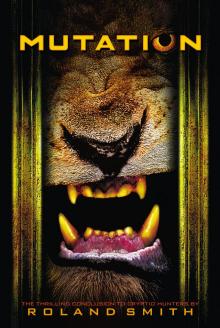 Mutation
Mutation Chromosome 6
Chromosome 6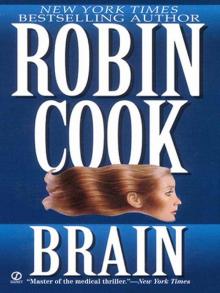 Brain
Brain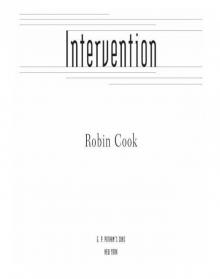 Intervention
Intervention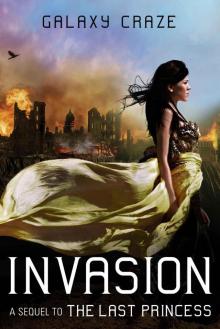 Invasion
Invasion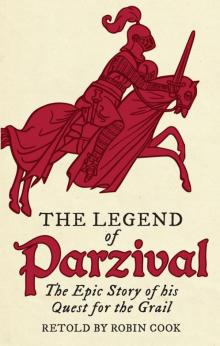 The Legend of Parzival: The Epic Story of His Quest for the Grail
The Legend of Parzival: The Epic Story of His Quest for the Grail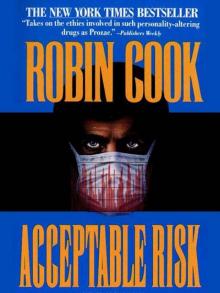 Acceptable Risk
Acceptable Risk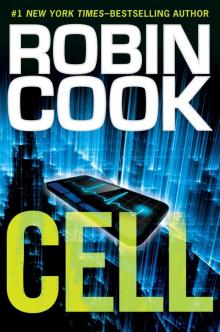 Cell
Cell Fever
Fever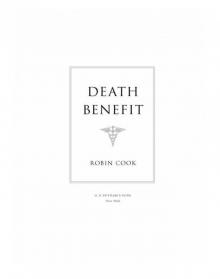 Death Benefit
Death Benefit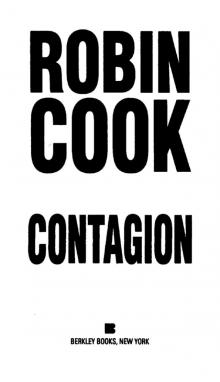 Contagion
Contagion Mindbend
Mindbend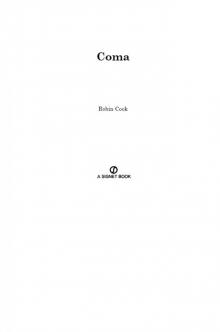 Coma
Coma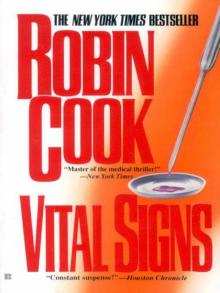 Vital Signs
Vital Signs Harmful Intent
Harmful Intent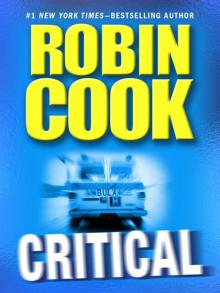 Critical
Critical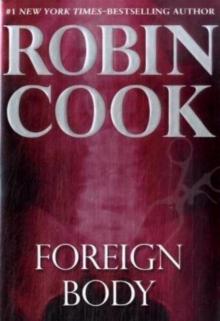 Foreign Body
Foreign Body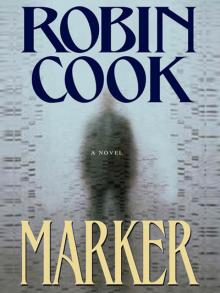 Marker
Marker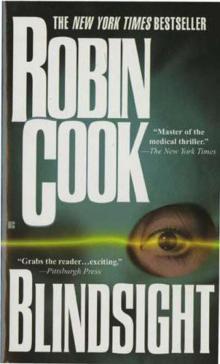 Blindsight
Blindsight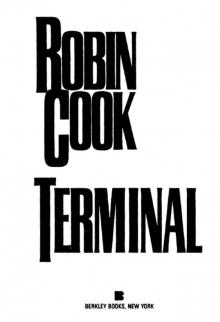 Terminal
Terminal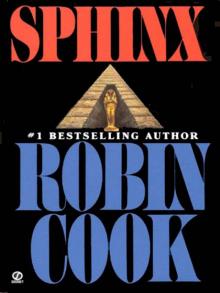 Sphinx
Sphinx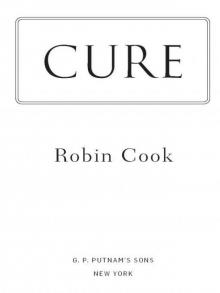 Fatal Cure
Fatal Cure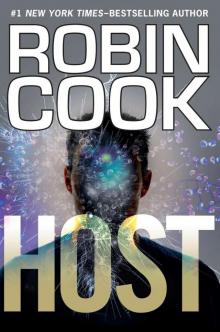 Host
Host Charlatans
Charlatans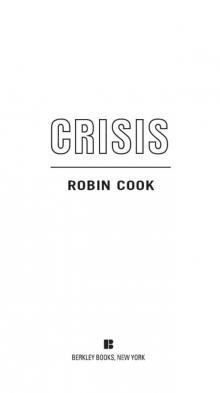 Crisis
Crisis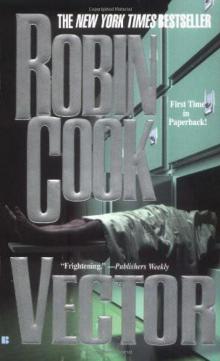 Vector
Vector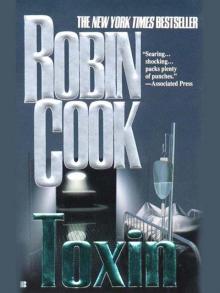 Toxin
Toxin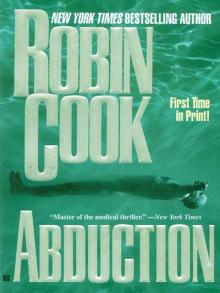 Abduction
Abduction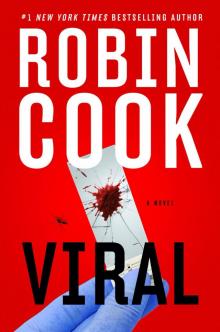 Viral
Viral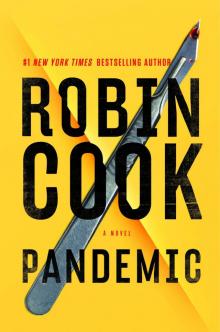 Pandemic
Pandemic Outbreak
Outbreak Vector js&lm-4
Vector js&lm-4 Godplayer
Godplayer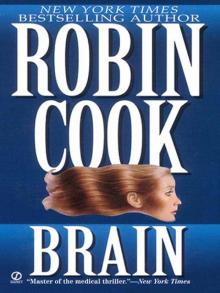 A Brain
A Brain Year of the Intern
Year of the Intern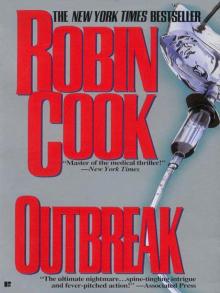 Outbreak dmb-1
Outbreak dmb-1 Cure
Cure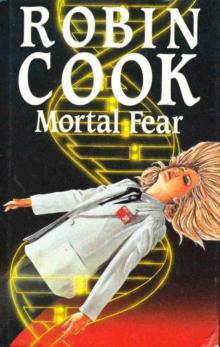 Mortal Fear
Mortal Fear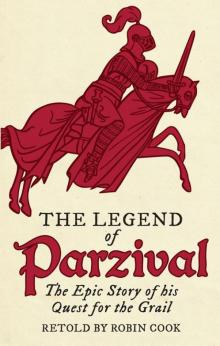 The Legend of Parzival
The Legend of Parzival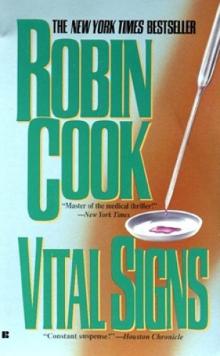 Vital Signs dmb-2
Vital Signs dmb-2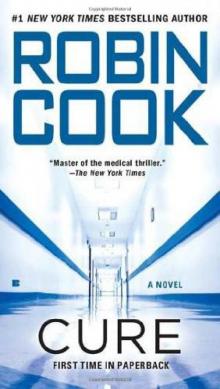 Cure (2010) sam-10
Cure (2010) sam-10 Blindsight sam-1
Blindsight sam-1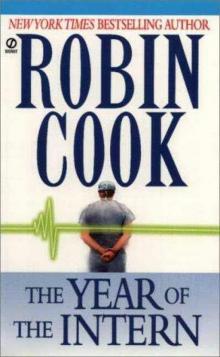 The Year of the Intern
The Year of the Intern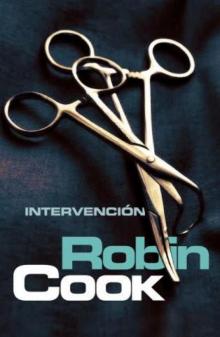 Intervention sam-9
Intervention sam-9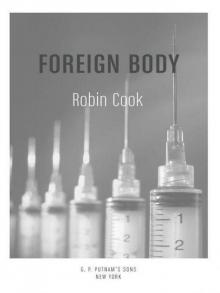 Foreign Body sam-8
Foreign Body sam-8